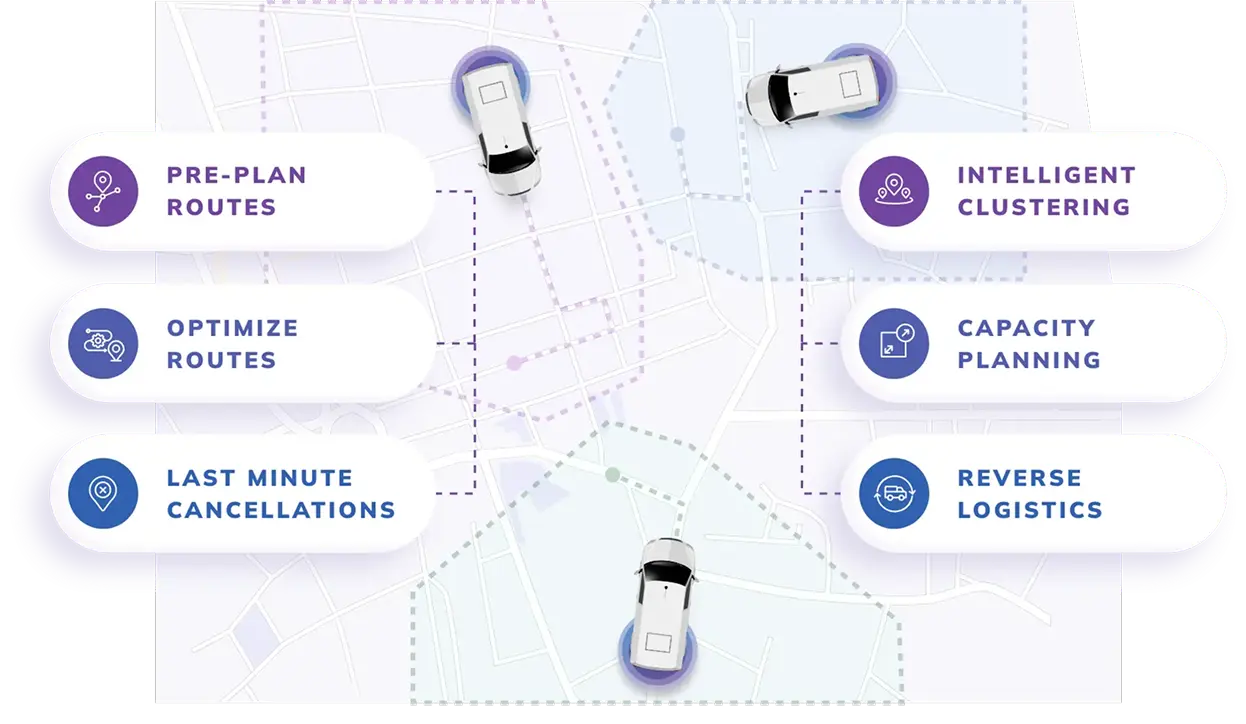

- BLOG
What Is Permit-Aware Navigation
Published: October 30, 2025
Route Optimization API
Optimize routing, task allocation and dispatch
Distance Matrix API
Calculate accurate ETAs, distances and directions
Directions API
Compute routes between two locations
Driver Assignment API
Assign the best driver for every order
Routing & Dispatch App
Plan optimized routes with 50+ Constraints
Product Demos
See NextBillion.ai APIs & SDKs In action
AI Route Optimization
Learns from Your Fleet’s Past Performance
Platform Overview
Learn about how Nextbillion.ai's platform is designed
Road Editor App
Private Routing Preferences For Custom Routing
On-Premise Deployments
Take Full Control of Your Maps and Routing
Trucking
Get regulation-compliant truck routes
Fleet Management
Solve fleet tracking, routing and navigation
Middle Mile Delivery
Optimized supply chain routes
Construction
Routes for Construction Material Delivery
Oil & Gas
Safe & Compliant Routing
Food & Beverage
Plan deliveries of refrigerated goods with regular shipments
Table of Contents

In industries like heavy haul transport, wind-tower logistics, abnormal loads, and specialty freight, many loads exceed standard dimensions and weights. These are often termed oversize/overweight (OS/OW) loads. Routing such loads safely and legally requires more than “just map + GPS”, it requires knowledge of permitted routes, infrastructure constraints (e.g., low bridges, narrow roads, weight limits), regulatory permits and real-time restrictions.
This is where permit-aware navigation (also called permit-based routing or oversize route navigation) comes in. At its core, permit-aware navigation means that the navigation or routing system is deliberately aware of:
In other words: instead of simply calculating the shortest or quickest route for a truck, the system computes a route that complies with the permit and the constraints, and then navigates accordingly.
We’ll explore what it means, how it works, the challenges, and then how a platform such as NextBillion.ai can support and enable this kind of routing capability.

Permit-based routing refers to the routing of a vehicle or load under a special permit (often because it is oversize, overweight or otherwise non-standard) in which the route itself is part of the permit. The permit may specify:
When routing must respect all those variables, you have permit-based routing.
Oversize route navigation is a subset of permit-based routing: focusing specifically on oversized or overweight loads. Such loads may have:
These impose infrastructure constraints (bridges, overhead wires, narrow or weak roads) and regulatory constraints (permits, special routes, escorts). So “oversize route navigation” emphasizes the navigation of those loads along compliant routes.
From research and industry practice:
Thus, permit-aware navigation is not just “turn left here”, it is “turn left here because your height is 14 ft, the overhead clearance is 14.2 ft, the permit requires movement after 9 am, and the road under the bridge supports your axle weight”.
Here are the typical components a system must have in order to perform permit-aware navigation effectively:
Why should logistics, heavy haul or transport operations care about permit-aware navigation? Here are some compelling business drivers:
While the benefits are significant, implementing permit-aware navigation is not trivial. Key challenges include:
Here is a structured FAQ schema block that you could embed in an article or blog to support SEO for “what is permit-aware navigation”.
<script type=”application/ld+json”>
{
“@context”: “https://schema.org”,
“@type”: “FAQPage”,
“mainEntity”: [
{
“@type”: “Question”,
“name”: “What is permit-aware navigation?”,
“acceptedAnswer”: {
“@type”: “Answer”,
“text”: “Permit-aware navigation is a routing and navigation system designed to guide vehicles – especially oversize or overweight loads – along a legally approved route that meets the conditions set out in the permit, by taking into account vehicle dimensions, road clearance, weight limits, and travel restrictions.”
}
},
{
“@type”: “Question”,
“name”: “What is permit-based routing?”,
“acceptedAnswer”: {
“@type”: “Answer”,
“text”: “Permit-based routing refers to generating and following a vehicle route that arises from an issued permit – the route is part of the permit, defined by the regulatory authority, and must be adhered to precisely.”
}
},
{
“@type”: “Question”,
“name”: “Why is oversize route navigation important?”,
“acceptedAnswer”: {
“@type”: “Answer”,
“text”: “Oversize route navigation is important because oversized and overweight loads face infrastructure constraints such as low bridges, narrow roads, weight-limited bridges, and require special permits and escort vehicles; proper navigation reduces risk, improves safety, and ensures legal compliance.”
}
},
{
“@type”: “Question”,
“name”: “What key components are required for permit-aware navigation?”,
“acceptedAnswer”: {
“@type”: “Answer”,
“text”: “Key components include: vehicle/load attribute data (dimensions, weight), permit data (approved route, travel window, restrictions), a geospatial network with clearance/weight metadata, a routing engine capable of constraint-based path search, navigation and monitoring tools, and integration with permit/regulatory systems.”
}
},
{
“@type”: “Question”,
“name”: “What are common challenges when implementing permit-aware navigation?”,
“acceptedAnswer”: {
“@type”: “Answer”,
“text”: “Common challenges include: obtaining accurate infrastructure and restriction data, integrating with permit-issuance processes, accommodating load variability, monitoring compliance in real time, scaling operations, and keeping dynamic restrictions (construction/closures) up to date.”
}
},
{
“@type”: “Question”,
“name”: “How can technology platforms help with permit-aware navigation?”,
“acceptedAnswer”: {
“@type”: “Answer”,
“text”: “Technology platforms can provide APIs and routing engines that support vehicle dimension constraints, specialized routing (truck/oversize), real-time traffic and infrastructure data, monitoring and alerts, route-compliance dashboards, and integration with ERPs or TMS – thereby automating much of the planning and execution.”
}
}
]
}
</script>
You can embed this JSON-LD in your website to support structured data and improve SEO visibility for permit-aware/permit-based routing topics.
Now that we’ve defined the concept and its requirements, let’s turn to how NextBillion.ai can help organisations implement permit-aware navigation.
Here are features of NextBillion.ai that map directly to the requirements of permit-based/oversize routing:
Here’s how a transport operator could implement permit-aware navigation using NextBillion.ai:
1. Load & permit capture
Refer here for API information.
2. Map & restriction configuration
3. Route generation
Refer here for API documentation on Directions API.
4. Navigation & monitoring
5. Updates & re-routing
6. Integration with business systems
Given the requirements of permit-aware navigation and the capabilities just outlined, NextBillion.ai offers compelling strengths:

For logistics and transport teams specialising in oversize/abnormal loads (or considering doing so), here’s a strategic framework:
1. Audit current process
2. Define requirements
3. Select a technology platform
4. Build the workflow
5. Benefit Realisation
6. Scale & Institutionalise
For this strategy, NextBillion.ai forms a solid technology foundation because it addresses multiple layers: mapping & network data, advanced routing algorithm, scalable infrastructure, integration readiness, and truck‐oversize support.
“Permit-aware navigation” (or “permit-based routing” / “oversize route navigation”) is an essential capability for companies transporting oversized or overweight loads. By embedding permit requirements, infrastructure constraints and vehicle/load specifications into the route planning and navigation process, carriers can reduce risk, ensure compliance, improve safety and optimise operations.
From the perspective of a logistics operations or technology manager, implementing such capability involves:
In this context, NextBillion.ai offers a platform that aligns very well with these needs: truck/oversize-capable routing, custom map editing, large-scale optimisation, API-first integration and global map data coverage.
If you are considering building or upgrading your oversize transport routing capability, you could adopt NextBillion.ai as the backbone of your “permit-aware navigation” system and then layer your business-specific permit logic, compliance workflows and dashboards. Its flexibility means you do not start from zero.
👉 So, without any delay book a demo with NextBillion.ai today and see how NextBillion.ai can help optimize your permit-aware oversize navigation.
Prabhavathi is a technical writer based in India. She has diverse experience in documentation, spanning more than 10 years with the ability to transform complex concepts into clear, concise, and user-friendly documentation.